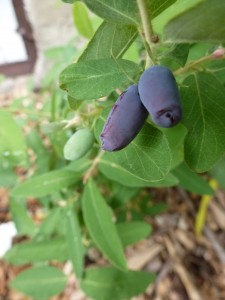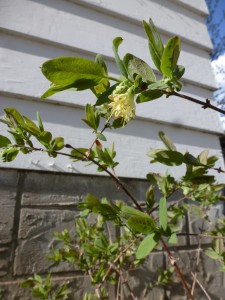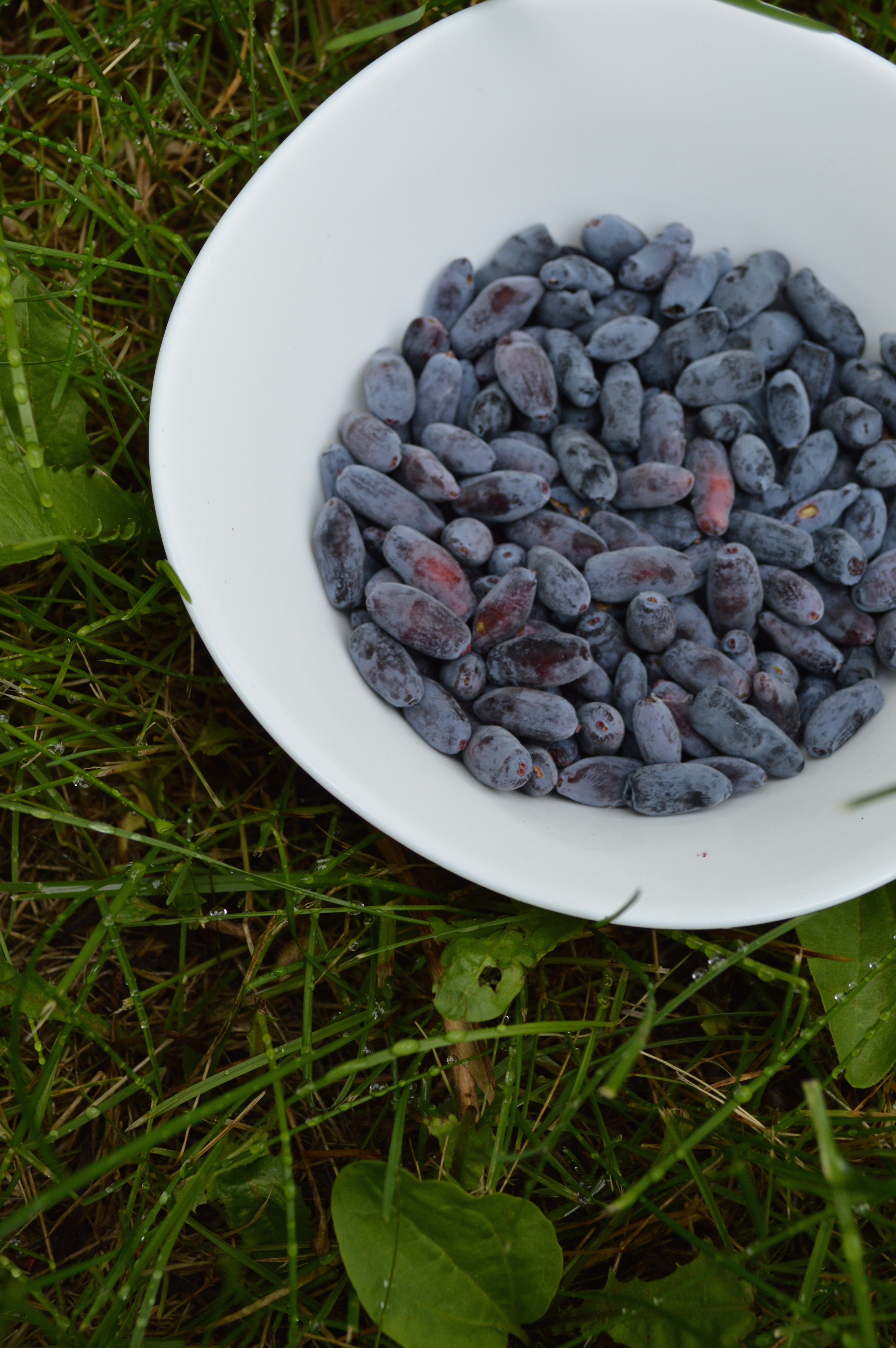This is one of those “probably more than you wanted to know about…” posts, but when one plant has a hundred names, I’m always curious for an explanation.
 A cold-hardy bush that produces delicious, anti-oxidant-rich berries of striking colour and interesting shapes as early as June, the haskap has captured the attention of a diverse group of obsessives: gardeners, nutritionists, chefs, and linguists, to name a few.
A cold-hardy bush that produces delicious, anti-oxidant-rich berries of striking colour and interesting shapes as early as June, the haskap has captured the attention of a diverse group of obsessives: gardeners, nutritionists, chefs, and linguists, to name a few.
Haskaps are native to several far flung regions in the northern hemisphere, and most often found in or near bogs in boreal forests. They go by a dizzying number of names, some of which are described below. For clarity’s sake, the plant we are discussing is Lonicera caerulea. There are four notable regions to which the plant is native, each with distinctive varieties and nomenclature.
Russia, where it goes by the name blue honeysuckle. The fruit of Russian varieties tends to ripen into long, thin, tart berries very early in the summer.
Japan, where the name is transliterated as haskap. Round, well-balanced fruit ripens in late summer.
The Kuril Islands, a volcanic archipelago stretching between northern Japan and the Kamchatka peninsula of Russia. These islands are under Russian administration, though Japan lays claim to some of the southernmost islands. The Kurils are notable because they are home to a unique variety of haskap that produce large berries very late in the season.
Canada. L. caerulea can be found wild in every province except BC. Our plants produce very small berries with unremarkable flavour, and go by a number of appetizing local names including swamp fly honeysuckle and mountain fly honeysuckle. Originally Canadian botanists classified these plants as L. villosa, believing it to be a unique species of honeysuckle. Recently it was discovered or decided that the Canadian plants are a variety of L. caerulea, so they are now classified as L. caerulea var. (or sometimes ssp.) villosa.
Haskaps in North America
The Beaverlodge “Sweetberry Honeysuckle”. The most notable contribution the native Canadian varieties of L. caerulea made was a shrub bred by Alberta’s Northern Agricultural Research Station, the Beaverlodge, in the 1950s. They developed two varieties of what they called sweetberry honeysuckle: the George Bugnet and the Marie Bugnet. These were intended as ornamental shrubs, even though the name strongly suggests edibility. They were used as low-maintenance hedges across North America and are still common in some cities.
Jim Gilbert “Honeyberry”. Much of the modern intensive breeding of haskaps in North America is thanks to Jim Gilbert of One Green World Nursery/Northwoods Nursery (why does this company have two names?) in Oregon. [Editor’s Note: see the comments section below for the answer to the two-name-question…] He made several trips to Russia and brought back the best varieties of their edible blue honeysuckle.
Back in America Gilbert branded the plants as honeyberries. He also renamed and trademarked all of the distinct varieties with friendly English names. Tomichka, for instance, became Blue Belle, and Chek#7 became Berry Blue. He promoted the plants aggressively, hoping that greenhouses would adopt his names and pay him royalties. Several nurseries ended up taking his plants and simply renaming them to skirt payment. A confusing array of varietal names proliferated, most involving the words “honey” or “blue”.
From 1997 to 2003 the University of Saskatchewan tested some of Gilbert’s honeyberry varieties, and concluded that Blue Belle produced the best fruit, and the Berry Blue was its best pollinator.
University of Saskatchewan “Haskap”. After testing Gilbert’s plants, the U of SK Fruit Program became very interested in L. caerulea because of its hardiness and high yields of delicious fruit. The U of SK decided to adopt the term haskap instead of honeyberry because their plants most resemble the native Japanese varieties. I use the term haskap most frequently, too, though I think it would be fun to serve the fruit in a restaurant as swamp fly honeysuckle…
In 2007 the U of SK released the Borealis and Tundra haskaps, which were hybrids of the Tomichka (Russian) and Kiev#7 (Kuril) varieties. They also released a closely-related “Indigo Series” with ridiculous names like Indigo Yum. They recently released the Honeybee variety as a good pollinator for all of the above.
The U of SK is currently interbreeding all four types of haskap (Russian, Japanese, Kuril, and Canadian) and selecting for eating quality, blooming and ripening time, and ease of mechanical harvest.
Growing Haskaps
 Last fall we planted two haskap bushes in our backyard: one Berry Blue, one Blue Belle. Haskaps require pollinators. In other words, there has to be another variety of the same species that flowers at the same time planted nearby for the bushes to produce fruit.
Last fall we planted two haskap bushes in our backyard: one Berry Blue, one Blue Belle. Haskaps require pollinators. In other words, there has to be another variety of the same species that flowers at the same time planted nearby for the bushes to produce fruit.
The first spring our haskaps were quick off the starting line, shooting out their spindly yellowish flowers while most other plants were struggling to produce leaves.
By late May there were small, green berries, and by early June some had enlarged and turned blue or indigo.
By mid to late June the season is in full swing, and we we expecting to harvest a couple pounds of deep blue berries. Unfortunately rapacious birds beat us to the fruit, and we gathered only a meager handful.
The following year we invested in some netting to protect the fruit.
The most common description of the flavour is “somewhere between blueberry and raspberry,” which just makes me think of all of those “blue raspberry” candies and sport drinks. Personally the flavour doesn’t remind me of a blueberry at all: I think that’s just the power of visual suggestion. The berries are tart, and very subtly bitter. They’re great out of hand.
Sources
This post is based largely on an article in The 2012 Prairie Garden called “Haskaps and Blue Honeysuckles: Types and Varieties” by Dr. Bob Bors, as well as information from the U of SK Fruit Program website.
